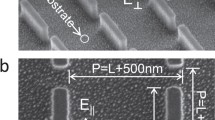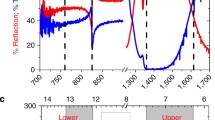Abstract
Plasmonics provides great promise for nanophotonic applications. However, the high optical losses inherent in metal-based plasmonic systems have limited progress. Thus, it is critical to identify alternative low-loss materials. One alternative is polar dielectrics that support surface phonon polariton (SPhP) modes, where the confinement of infrared light is aided by optical phonons. SiC nanopillar arrays support such modes, exhibiting a dipolar resonance transverse to the nanopillar axis and a monopolar resonance associated with the longitudinal axis dependent upon the SiC substrate. Both exhibit exceptionally narrow linewidths (7–24 cm−1), with quality factors of 40–135, which exceed the theoretical limit of plasmonic systems, with extreme subwavelength confinement of (λres3/Veff)1/3 = 50–200. These observations promise to reinvigorate research in SPhP phenomena and their use for nanophotonic applications. Another approach is the use of hyperbolic materials, which have been a focus of the nanophotonics community for their potential to realize sub-diffractional imaging and focusing of light, and novel optical properties, such as a negative index of refraction. The recent observation that hexagonal boron nitride (hBN) is a natural, high efficiency hyperbolic material has led to a surge in research within this field. Due to the low-loss nature, van der Waals bonding and extreme crystal anisotropy, the hyperbolic polaritons within hBN are not only promising for novel applications within the mid-infrared, but is also extremely well suited for fundamental investigations into their resonant behaviors. We have used scattering near-field optical microscopy (s-SNOM) to directly probe the local surface electromagnetic fields of three-dimensionally confined nanostructures of hBN, reporting the first experimental observation of frequency dependent internal angular reflection within a hyperbolic nanostructure, a phenomenon previously theoretically predicted.
Access provided by CONRICYT-eBooks. Download conference paper PDF
Similar content being viewed by others
Keywords
These keywords were added by machine and not by the authors. This process is experimental and the keywords may be updated as the learning algorithm improves.
FormalPara AbstractPlasmonics provides great promise for nanophotonic applications. However, the high optical losses inherent in metal-based plasmonic systems have limited progress. Thus, it is critical to identify alternative low-loss materials. One alternative is polar dielectrics that support surface phonon polariton (SPhP) modes, where the confinement of infrared light is aided by optical phonons. SiC nanopillar arrays support such modes, exhibiting a dipolar resonance transverse to the nanopillar axis and a monopolar resonance associated with the longitudinal axis dependent upon the SiC substrate. Both exhibit exceptionally narrow linewidths (7–24 cm−1), with quality factors of 40–135, which exceed the theoretical limit of plasmonic systems, with extreme subwavelength confinement of (λres3/Veff)1/3 = 50–200. These observations promise to reinvigorate research in SPhP phenomena and their use for nanophotonic applications. Another approach is the use of hyperbolic materials, which have been a focus of the nanophotonics community for their potential to realize sub-diffractional imaging and focusing of light, and novel optical properties, such as a negative index of refraction. The recent observation that hexagonal boron nitride (hBN) is a natural, high efficiency hyperbolic material has led to a surge in research within this field. Due to the low-loss nature, van der Waals bonding and extreme crystal anisotropy, the hyperbolic polaritons within hBN are not only promising for novel applications within the mid-infrared, but is also extremely well suited for fundamental investigations into their resonant behaviors. We have used scattering near-field optical microscopy (s-SNOM) to directly probe the local surface electromagnetic fields of three-dimensionally confined nanostructures of hBN, reporting the first experimental observation of frequency dependent internal angular reflection within a hyperbolic nanostructure, a phenomenon previously theoretically predicted.
References
Caldwell, J. D., et al. (2014). Nature Communications, 5, 5221.
Dai, S., et al. (2014). Science, 343, 1125–1129.
Caldwell, J. D. et al. (2014). Nanophotonics.
Caldwell, J. D., et al. (2013). Nano Letters, 13, 3690.
Acknowledgments
A.J.G. acknowledges support from the NRC NRL Postdoctoral Fellowship Program, while project funding was provided via the Office of Naval Research and distributed by the Nanoscience Institute at the Naval Research Society.
Author information
Authors and Affiliations
Corresponding author
Editor information
Editors and Affiliations
Rights and permissions
Copyright information
© 2017 Springer Science+Business Media Dordrecht
About this paper
Cite this paper
Giles, A.J. et al. (2017). Low-Loss Phonon Polaritons in Nanostructured Dielectrics. In: Di Bartolo, B., Collins, J., Silvestri, L. (eds) Nano-Optics: Principles Enabling Basic Research and Applications. NATO Science for Peace and Security Series B: Physics and Biophysics. Springer, Dordrecht. https://doi.org/10.1007/978-94-024-0850-8_54
Download citation
DOI: https://doi.org/10.1007/978-94-024-0850-8_54
Published:
Publisher Name: Springer, Dordrecht
Print ISBN: 978-94-024-0848-5
Online ISBN: 978-94-024-0850-8
eBook Packages: Physics and AstronomyPhysics and Astronomy (R0)




